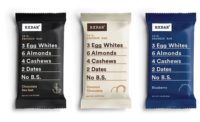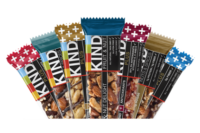 Cinnamon buns — those gooey, sugary treats — are about as far away from a general definition of “healthy” as you can get.
Cinnamon buns — those gooey, sugary treats — are about as far away from a general definition of “healthy” as you can get.
But that’s exactly what one of the latest so-called healthy treats offered by the Balance Bar Co. are supposed to taste like. The nutrition and energy bars manufacturer introduced the flavor as part of its Café line last year in an effort to cater to the impulses of a certain type of customer — the healthy snacker.
“We want to serve the life athlete, the person on the go, someone who wants a healthy snack or a meal replacement,” says Peter Wilson, president and ceo of Balance Bar. “We are not specifically aimed at recovery.”
In other words, these energy and nutrition bars are now being marketed to health-conscious consumers who want a snack, as opposed to for athletes looking to re-energize after a strenuous work-out. For Balance Bar, the key is making a product relevant for both audiences.
“We are not specifically targeting the athlete, but the bar can definitely help pre or post workout,” says Erin Lifeso, director of marketing at Balance Bar. “We are not segmenting our bars to specialize in recovery, but they can still be used in that manner.”
And the data suggests Balance Bar is on to something.
The most recent data available from Symphony IRI showed a 16.3% increase in dollar sales for nutritional bars, compared to last year for the week ending Jan. 22. Moreover, Datamonitor research shows that the fastest growing segment of the energy category is the everyday consumer who cares about healthy snacking.
Meanwhile, a 2011 International Food Informational Council Foundation study found that 59% of Americans reported making changes to their diet to improve their health, and 69% were trying to lose or maintain their weight.
As a result, companies are creating broader product lines in an effort to get their share of these consumers. Take the cinnamon bun bar for example. It’s part of a line of what Wilson calls “occasional bars,” meant to appeal to impulse purchasers in certain situations. Café bars are for consumers sitting down to drink a cup of coffee and looking for a healthy snack.
“In the case of Café, we thought it might appeal to the wider, growing audience that is interested in healthy energy bars,” says Wilson.
Mars Chocolate Co. also emphasizes its attempts to reach out to a more general audience, using the term “daily performers” to describe everyday people trying to keep active in enjoyable ways.
“Our core consumers are adults 18 to 34 years old who are choosing to consume sports nutritional products as an initial building block in leading a healthier lifestyle,” says Tim Quinn, v.p. of trade development, Mars Chocolate North America. “They mainly consume sports nutrition products in order to provide a quick meal replacement or simply a healthy snack.”
The focus on the health-conscious consumer comes in the wake of research that confirms the interest in energy and nutritional bars increasing among a previously untapped audience. As average consumers become more health conscious, the demand has shifted toward healthy snacking.
Of course, the definition of a healthy snack is always in flux — which is why both Balance Bar and Mars have different approaches to the question of nutrition.
Balance Bar’s take on nutrition involves the 40/30/30 plan, also known as the Zone diet. All of the company’s products are made so that 40% of total calories come from carbohydrates, 30% from protein, and 30% from dietary fats.
“We are going after people who want and need the broad nutritional spectrum that we offer,” says Wilson. “This plan manages the blood sugar well and gives you balanced, long lasting energy.”
Mars, on the other hand, produces several different types of products to serve the nutritional needs of multiple audiences, offering nutrition, energy, and protein bars.
Its Marathon Smart Stuff line of bars — made with teens in mind — are created to comply with the Alliance for a Healthier Generation Competitive Food Guidelines for Snacks, which require snacks to have less than 35% calories from fat, 10% calories from saturated fat and less than 35% of weight from sugar.
Of course, whatever guidelines companies choose to follow, consumers won’t continually buy their products unless they taste good.
“For nutrition bars, the decision process is typically nutritional first — protein or energy, then flavor,” says Quinn. “[But] flavor fatigue is common within the energy/nutrition bar category.”
Balance Bar starts with high quality protein for its bar, bringing grains into the core of the product, and then adding the flavors last. Thus, any foray into new flavors has to be accompanied by advances in manufacturing technology.
“There have been advances in capsulation and how the vitamins are presented in our matrix — these advances help maintain the flavors that the flavor houses provide,” says Wilson.|
These advances may help the development of new and more indulgent flavors in the nutrition and energy bar sector, but one thing will remain the same for Balance Bar: the focus on nutrition.
“It’s not just about getting a bar in someone’s mouth for us, it’s about nutrition,” says Wilson. “The greatest service we can offer to our customers is offering a great taste and a lot of nutrition in that bar.”
For now, that means offering cinnamon bun alternatives to customers looking for a sticky-sweet treat without the guilt.




